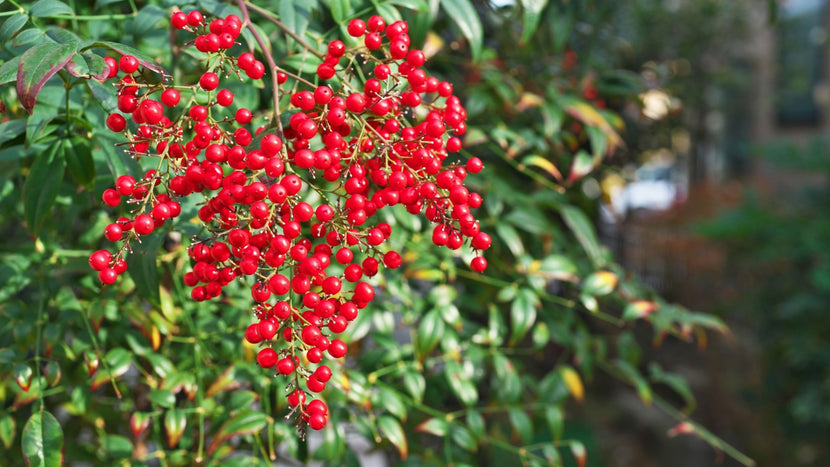
Growing Nandinas in the Garden Responsibly
Nandinas: Good Plant, Bad Rep
Nandina domestica or Heavenly bamboo, is an easy to grow evergreen or semi-evergreen shrub that looks good in all four seasons. Its colorful foliage sports reds, greens, and yellows. In the early spring, Nandinas bear sprays of tiny white flowers.
In early summer green berries begin to appear. These turn to bright red berries in autumn, as the foliage takes on fiery red, bronze, or golden colors. The foliage remains on the plant throughout winter, adding color and texture to the garden.
There's a problem with Nandinas, however, but it is easily dealt with. Over the last few years, it has been discovered that Nandina seeds are easily spread by the local bird population. The berries are among the few berries that last all winter.
One reason for this is that birds don’t really like them. They only eat them after they’ve exhausted all other native plant food sources.
Do Nandina Berries kill birds?
Nandina is one of those plants that people either love or hate. According to posts shared across social media some years ago, nandina berries poison birds.
Many of these reports stem from a single incident that occurred in Thomas County, Georgia in April 2009. Somebody found and notified the Audobon society that they found a number of dead cedar waxwings in their yard. Upon examination, the deceased birds were stuffed with nandina berries. Nandina berries contain small amounts of cyanide.
A couple of berries may sicken a bird, but not kill it. Cedar waxwings, unfortunately, don’t stop with a couple of berries. When a flock of these social birds descends upon a garden, they will strip a holly, crabapple, dogwood, in minutes. This is what happened in Thomas County, Georgia.
This is the only recorded case of this phenomenon so it's safe to say it was an isolated incident. It should also be noted that there are over 2000 different species of plants that produce seeds that contain cyanide, including apples.
Is Nandina an Invasive Plant?
To say that Nandina is an invasive species is similar to saying that all roses are red. We know this is not true and while many of the older types of Heavenly Bamboos are considered by some to be invasive not all are. In fact, many of the newer dwarf nandina plants rarely if ever produce flowers and berries.
The seeds of nandina are contained in the berries, which when eaten by birds are deposited into areas where they can grow unchecked. Barberry plants, for example, have been found to be invasive in the northeastern region of the United States.
How to Prevent Nandinas from Becoming Invasive
Rather than get into the science of why and if nandinas are invasive, I feel it's better to discuss how to stop nandinas from escaping the garden and entering into wildlands. For this part, we will be discussing two particular varieties of Nandina which are known to produce large amounts of berries. Nandina domestica and Nandina Gulfstream are two readily available varieties of Nandina that are available in most Garden Centers. Both are very colorful and older varieties and can reach heights up to 5 feet tall.
There are two ways to keep this plant from reproducing and becoming invasive. Both methods are the same but are done at different times. First, in the spring you can simply remove the flowers. This is easily done on this particular type of plant as they rise above the foliage on a stem.
The second method and a preferred method is after the flowers have faded and the berries begin to form, once again just remove the flowering stem.
Simple enough and this will give you the satisfaction of being a great steward of the environment.
Non-flowering Dwarf Nandinas
There are many new varieties of Nandinas on the market today that do not flower or set seed. We refer to these as "Sterile Varieties". Southern Living Plants is the leader in this new breeding line, probably mostly in part to being headquartered in the states where nandinas are most known to be invasive.
You’ll find a number of them in our Nandina Collection. Nandina ‘Flirt’, Nandina ‘Obsession’, Nandina ‘Blush Pink’, and Nandina ‘Lemon-Lime’ are just 4 of the many new sterile varieties. In addition to not producing berries, these compact plants do not spread by roots the way the older nandinas do.
They mostly remain under 2.5 to 3 feet in height. Being dwarf varieties they can also be grown in containers on decks and patios for extended periods of time.
Planting Nandinas in the Garden
Nandinas are very forgiving and will happily grow in various light conditions from full sun to part shade. They tolerate most soil conditions from moist soil through well-drained soil. When planting be sure to not overdo it when using a soil amendment such as compost as nandinas tend to thrive in lean soil.
